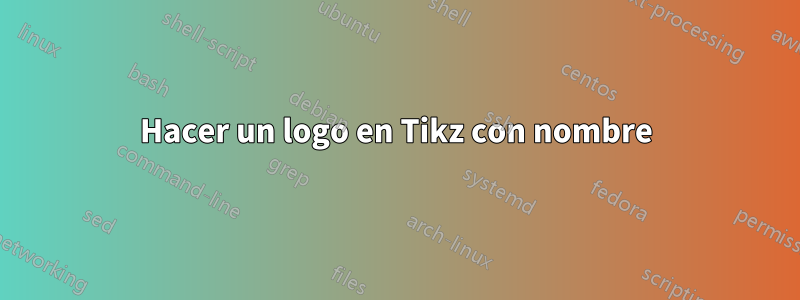
Estoy intentando hacer un pequeño logo con látex. Hago un dibujo (un árbol de decisión) y me gustaría agregar un texto al lado. Además, necesito que el dibujo sea pequeño, del tamaño del texto al lado.
Sólo una imagen aleatoria para mostrar qué tipo de forma me gustaría tener:
Hasta ahora hice el dibujo donde intenté agregar algo de texto al lado. Desafortunadamente no hay resultados.
\documentclass{scrartcl}
\usepackage[a4paper,margin=1cm,landscape]{geometry}
\usepackage{tikz}
%%%<
\usepackage{verbatim}
\usepackage[active,tightpage]{preview}
\PreviewEnvironment{tikzpicture}
\setlength\PreviewBorder{5pt}%
%%%>
\usetikzlibrary{positioning,shadows,arrows}
\begin{document}
\begin{figure}
\begin{minipage}[c]{7cm}
\begin{tikzpicture}[
state/.style={circle, draw=none, fill=orange, circular drop shadow,
text centered, anchor=north, text=white},
leaf/.style={circle, draw=none, fill=red, circular drop shadow,
text centered, anchor=north, text=white},
level distance=0.5cm, growth parent anchor=south
]
\node (State00) [state] {$X$}
child{ [sibling distance=3cm]
node (State01) [state] {$f(x)_{1}$}
child{
child{ [sibling distance=2cm]
node (State02) [state] {$f(x)_{11}$}
child{
child{
node (State03) [leaf] {$\hat{y}_{1}$}
}
}
child{
child{ [sibling distance=2.0cm]
node (State04) [state] {$\hat{y}_{2}$}
}
}
}
}
child{ [sibling distance=2cm]
child{
node (State10) [state] {$f(x)_{12}$}
child{
child{
node (State11) [leaf] {$\hat{y}_{3}$}
}
}
child{
child{
node (State12) [state] {$\hat{y}_{4}$}
}
}
}
}
}
;
\end{tikzpicture}]
\end{minipage}%
\begin{minipage}[c]{\textwidth-7cm}
Some text describing the image.
Some text describing the image.
Some text describing the image.
\end{minipage}
\end{figure}
\end{document}
El resultado tiene el siguiente aspecto:

Y el texto debería tener esta forma:
\documentclass{article}
\pagestyle{empty}
\usepackage{xcolor}
\usepackage{bm}
\usepackage{setspace}
\begin{document}
\setstretch{0.5}
\begin{center}
Nam$\textcolor{orange}{\bm{{\hat{e}}}}$ of New \\
~\\
Team
\end{center}
¿Podría indicarme la solución?
EDITAR
Con ayuda de @Guilherme Zanotelli, lo hice funcionar y establecí las proporciones adecuadas. Pero el logo es muy pequeño cuando lo guardo en pdf.
¿Cómo puedo hacerlo más grande manteniendo la proporción sin cambios?
resuelto con fuente más grande
Respuesta1
No entiendo cuál es realmente la pregunta, pero supongo que una de las cuestiones es conseguir que Nam*ê* of New Teamaparezca en el lado derecho del árbol de decisiones.
A continuación se muestra una forma de hacerlo dentro de tikzpicture (no se necesitan minipáginas).
\documentclass{article}
\usepackage[a4paper,margin=1cm,landscape]{geometry}
\usepackage{tikz,pbox}
\usepackage{xcolor}
\usepackage{bm}
\usepackage{setspace}
%%%<
\usepackage{verbatim}
\usepackage[active,tightpage,floats]{preview}
\PreviewEnvironment{tikzpicture}
\setlength\PreviewBorder{5pt}%
%%%>
\usetikzlibrary{positioning,shadows,arrows}
\begin{document}
\begin{figure}[h]
\begin{tikzpicture}[
state/.style={circle, draw=none, fill=orange, circular drop shadow,
text centered, anchor=north, text=white},
leaf/.style={circle, draw=none, fill=red, circular drop shadow,
text centered, anchor=north, text=white},
level distance=0.5cm, growth parent anchor=south
]
\node (State00) [state] {$X$}
child{ [sibling distance=3cm]
node (State01) [state] {$f(x)_{1}$}
child{
child{ [sibling distance=2cm]
node (State02) [state] {$f(x)_{11}$}
child{
child{
node (State03) [leaf] {$\hat{y}_{1}$}
}
}
child{
child{ [sibling distance=2.0cm]
node (State04) [state] {$\hat{y}_{2}$}
}
}
}
}
child{ [sibling distance=2cm]
child{
node (State10) [state] {$f(x)_{12}$}
child{
child{
node (State11) [leaf] {$\hat{y}_{3}$}
}
}
child{
child{
node (State12) [state] {$\hat{y}_{4}$}
}
}
}
}
};
\node[right] at (current bounding box.east) {\pbox{\textwidth}{\relax\ifvmode\centering\fi Nam$\textcolor{orange}{\bm{{\hat{e}}}}$ of New \\
~\\
Team}};
\end{tikzpicture}
\end{figure}
\end{document}
Respuesta2
Esta es una adaptación deLa respuesta de Guilherme Zanotelli, usando Forest, del cual soy más bien fuente. También usa, standalonelo cual es menos complicado, en mi opinión, que preview(pero usa preview, dependiendo de la configuración).
En un logotipo, una decisión clave será la elección de la fuente. Si bien no estoy seguro de qué recomendaría, ya que depende en gran medida del contexto y la audiencia, es poco probable que Computer Modern sea una buena opción. Solo como ilustración, lo uso kpfontsen el siguiente ejemplo.
También me propuse demostrar cómo seleccionar un tamaño de fuente arbitrario para el texto de la derecha. El primer número es el tamaño en puntos. El segundo es el salto de línea de base. Las fuentes escalables son cruciales. De forma predeterminada, probablemente obtenga el mapa de bits Computer Modern. Todo muy bien a su manera, pero aquí es absolutamente inadecuado. (Si desea CM, utilícelo \usepackage[T1]{fontenc}solo para asegurarse de obtener versiones escalables).
Aumenté el ancho de las líneas en el árbol porque no quieres que las líneas desaparezcan si el logotipo se usa en tamaño pequeño. Al menos supongo que no.
\documentclass[border=10pt,multi,tikz,border=5pt]{standalone}
\usepackage{forest,bm}
\usetikzlibrary{shadows}
\usepackage[T1]{fontenc}
\usepackage{kpfonts}
\begin{document}
\begin{forest}
state/.style={fill=orange},
leaf/.style={fill=red},
for tree={
text centered,
child anchor=parent,
text=white,
circle,
circular drop shadow,
math content,
state,
font=\large,
edge={line width=1pt},
},
for descendants={
edge path'={(.child anchor) -- +(0,7.5mm) -- (!u.parent anchor)},
l sep'=15mm,
},
l sep'=7.5mm,
where n children=0{
!u.s sep'=15mm,
}{},
[X
[f(x)_{1}
[f(x)_{11}
[\hat{y}_{1}, leaf]
[\hat{y}_{2}]
]
[f(x)_{12}
[\hat{y}_{3}, leaf]
[\hat{y}_{4}]
]
]
]
\node [right, align=center, font=\fontsize{50pt}{75pt}\selectfont] at (current bounding box.east) {Nam$\textcolor{orange}{\bm{{\hat{e}}}}$ of New\\Team};
\end{forest}
\end{document}





